Bootstrap Popover Button
Intro
The versions
Bootstrap is one of the most totally free and useful open-source platforms to design websites. The current version of the Bootstrap system is known as the Bootstrap 4. The platform is at the moment in its alpha-testing level nevertheless is accessible to website designers all over the world. You can also develop and advise modifications to the Bootstrap 4 before its final version is launched.
Usefulness of the Bootstrap 4
By using Bootstrap 4 you have the ability to generate your site now faster than ever. It is quite incredibly simpler to work with Bootstrap to build your web site than some other programs. Having the integration of HTML, CSS, and JS framework it is among the absolute most leading programs for web site improvement.
A number of elements plus techniques in Bootstrap 4
Some of the most recommended components of the Bootstrap 4 provide:
• An improvised grid structure that helps the user to get mobile device friendly with a fair level of comfort.
• A number of utility guidance sets have been featured in the Bootstrap 4 to help with very easy learning for starters in the field of web site design.
Facts to consider
Step 2: Rewrite your article by highlighting words and phrases.
, the ties to the older version, Bootstrap 3 have not been completely cut off. The developers has made sure that the Bootstrap 3 does get regular improve and bug fixes along with improvements.
Differences between Bootstrap 4 and Bootstrap 3
• The service for many different internet browsers including running systems has been featured in the Bootstrap 4
• The global size of the font style is improved for relaxing observing and web-site advancement practical experience
• The renaming of many components has been done to guarantee a much faster and even more reliable web-site development method
• Having brand new customizations, it is attainable to establish a more interactive site with nominal efforts
Bootstrap Popover HTML
And right away let us come to the essential material.
In case you need to bring in some additional info on your web site you have the ability to employ popovers - just incorporate little overlay content.
Exactly how to use the popover plugin:
- Bootstrap Popover Options lean at the 3rd side library Tether for installing. You have to utilize tether.min.js right before bootstrap.js needed for popovers to perform!
- Popovers demand the tooltip plugin as a dependence .
- Popovers are opt-in for performance reasons, so that you need to activate them yourself.
- Zero-length title and content values will certainly never present a Bootstrap Popover Position.
- Specify container:'body' to evade rendering issues within more complex elements (like Bootstrap input groups, button groups, etc).
- Triggering popovers on hidden components will just not run.
- Popovers for . disabled or disabled features need to be triggered on a wrapper element. - Whenever activated from website links that span several lines, popovers will certainly be centralized. Use white-space: nowrap; on your <a>-s to keep away from this kind of behavior.
Did you understood? Great, let us view how they perform with some good examples.
You need to include tether.min.js right before bootstrap.js needed for popovers to function!
Good example: Enable popovers everywhere
One way to initialize each of popovers on a web page would be to choose them by their data-toggle attribute:
$(function ()
$('[data-toggle="popover"]').popover()
) As an example: Using the container opportunity
Whenever you obtain several designs on a parent feature that intrude with a popover, you'll really want to define a custom container to ensure that the popover's HTML shows up within that component instead.
$(function ()
$('.example-popover').popover(
container: 'body'
)
)Static popover
Four selections are readily available: top, right, lowest part, and left lined up.
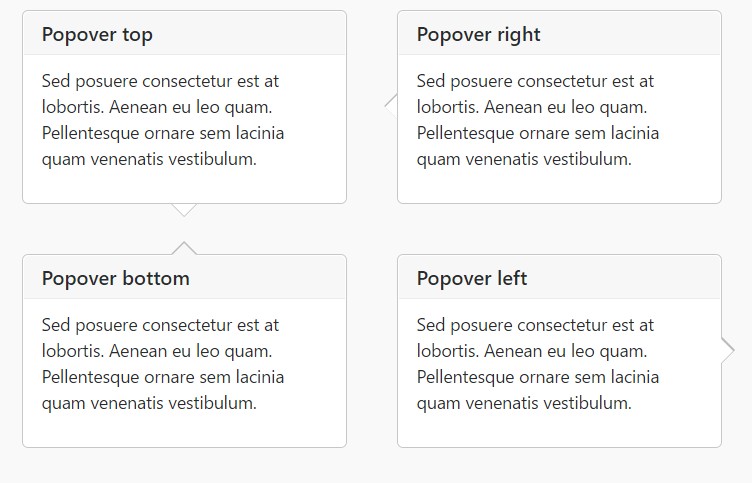
Live demonstration

<button type="button" class="btn btn-lg btn-danger" data-toggle="popover" title="Popover title" data-content="And here's some amazing content. It's very engaging. Right?">Click to toggle popover</button>Four trajectories

<button type="button" class="btn btn-secondary" data-container="body" data-toggle="popover" data-placement="top" data-content="Vivamus sagittis lacus vel augue laoreet rutrum faucibus.">
Popover on top
</button>
<button type="button" class="btn btn-secondary" data-container="body" data-toggle="popover" data-placement="right" data-content="Vivamus sagittis lacus vel augue laoreet rutrum faucibus.">
Popover on right
</button>
<button type="button" class="btn btn-secondary" data-container="body" data-toggle="popover" data-placement="bottom" data-content="Vivamus
sagittis lacus vel augue laoreet rutrum faucibus.">
Popover on bottom
</button>
<button type="button" class="btn btn-secondary" data-container="body" data-toggle="popover" data-placement="left" data-content="Vivamus sagittis lacus vel augue laoreet rutrum faucibus.">
Popover on left
</button>Dismiss on next mouse click
Use the focus trigger to turn out popovers on the next hit that the user makes.
Specialised markup demanded for dismiss-on-next-click
For proper cross-browser as well as cross-platform behavior, you need to work with the <a> tag, not the <button> tag, plus you in addition have to provide a tabindex attribute.

<a tabindex="0" class="btn btn-lg btn-danger" role="button" data-toggle="popover" data-trigger="focus" title="Dismissible popover" data-content="And here's some amazing content. It's very engaging. Right?">Dismissible popover</a>$('.popover-dismiss').popover(
trigger: 'focus'
)Usage
Enable popovers by JavaScript
$('#example').popover(options)Possibilities
Selections may be successfully pass with information attributes as well as JavaScript. For information attributes, append the option name to data-, as in data-animation="".

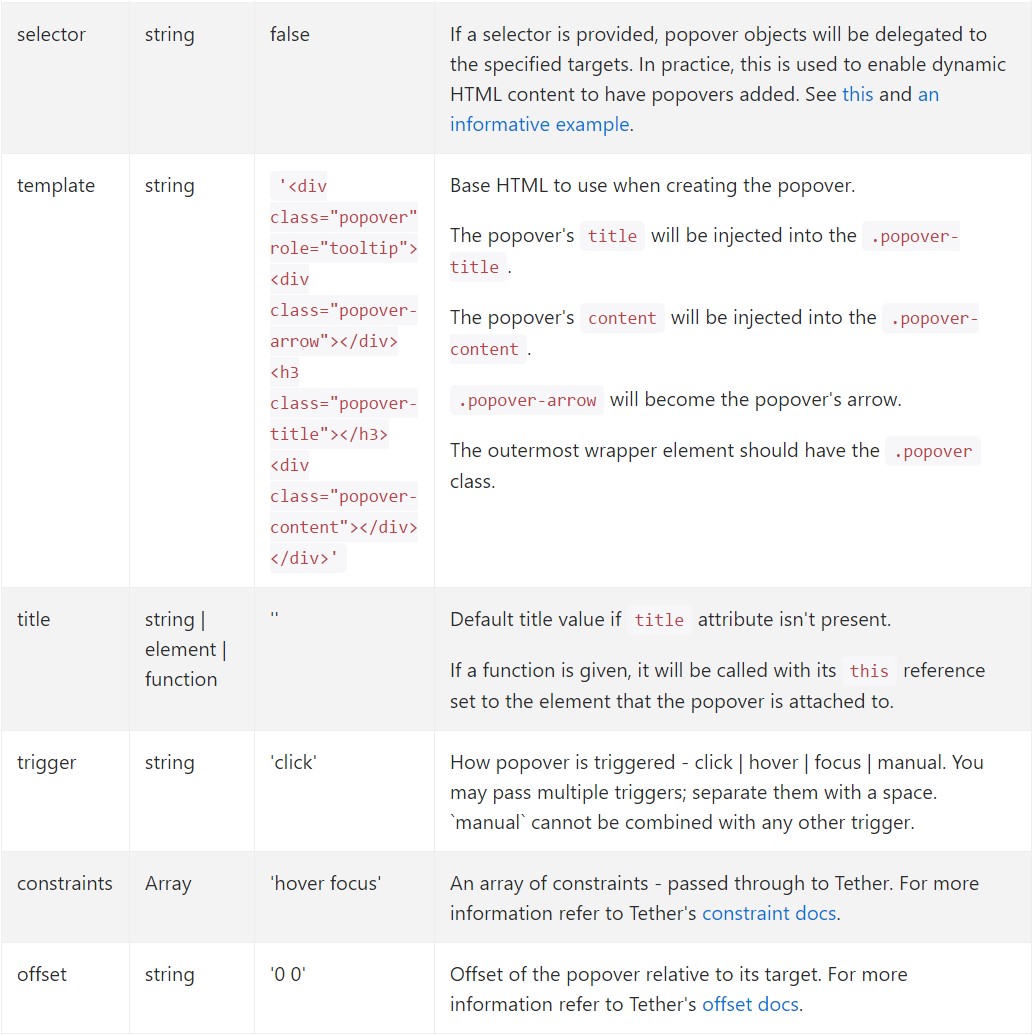
Data attributes for specific popovers
Selections for specific popovers have the ability to additionally be indicated via the use of data attributes, being explained above.
Solutions
$().popover(options)
Initializes popovers for the component variety.
.popover('show')
Reveals an element's popover. Come back to the user before the popover has certainly been shown (i.e. before the shown.bs.popover event occurs). This is regarded as a "manual" triggering of the popover. Popovers whose both title and content are zero-length are never featured.
$('#element').popover('show')
.popover('hide')
Disguises an element's popover. Returns to the caller right before the popover has in fact been covered (i.e. prior to the hidden.bs.popover activity happens). This is considered a "manual" triggering of the popover.
$('#element').popover('hide')
.popover('toggle')
Activate an element's popover. Returns to the caller just before the popover has actually been demonstrated or taken cover (i.e. just before the shown.bs.popover or hidden.bs.popover activity takes place). This is looked at a "manual" triggering of the popover.
$('#element').popover('toggle')
.popover('dispose')
Disguise and destroys an element's popover. Popovers that put to use delegation (which are generated using the selector option) can not actually be individually gotten rid of on descendant trigger features.
$('#element').popover('dispose')
Events

$('#myPopover').on('hidden.bs.popover', function ()
// do something…
)
Take a look at a few video clip tutorials regarding Bootstrap popovers
Related topics:
Bootstrap popovers official documentation
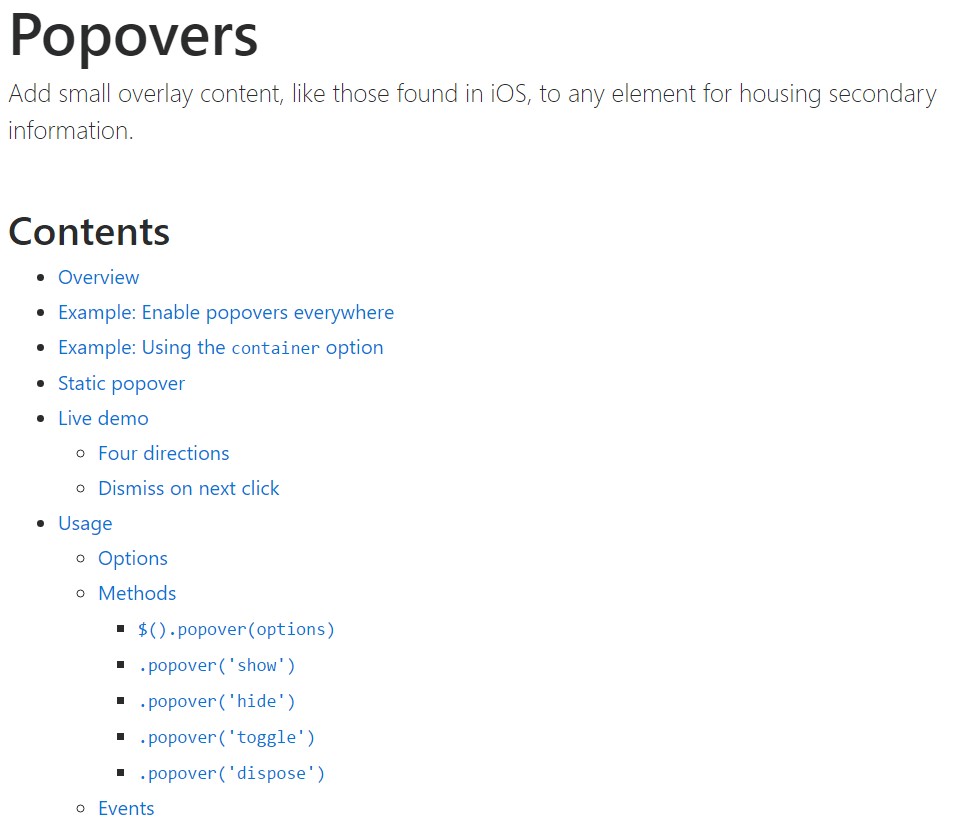
Bootstrap popovers short training
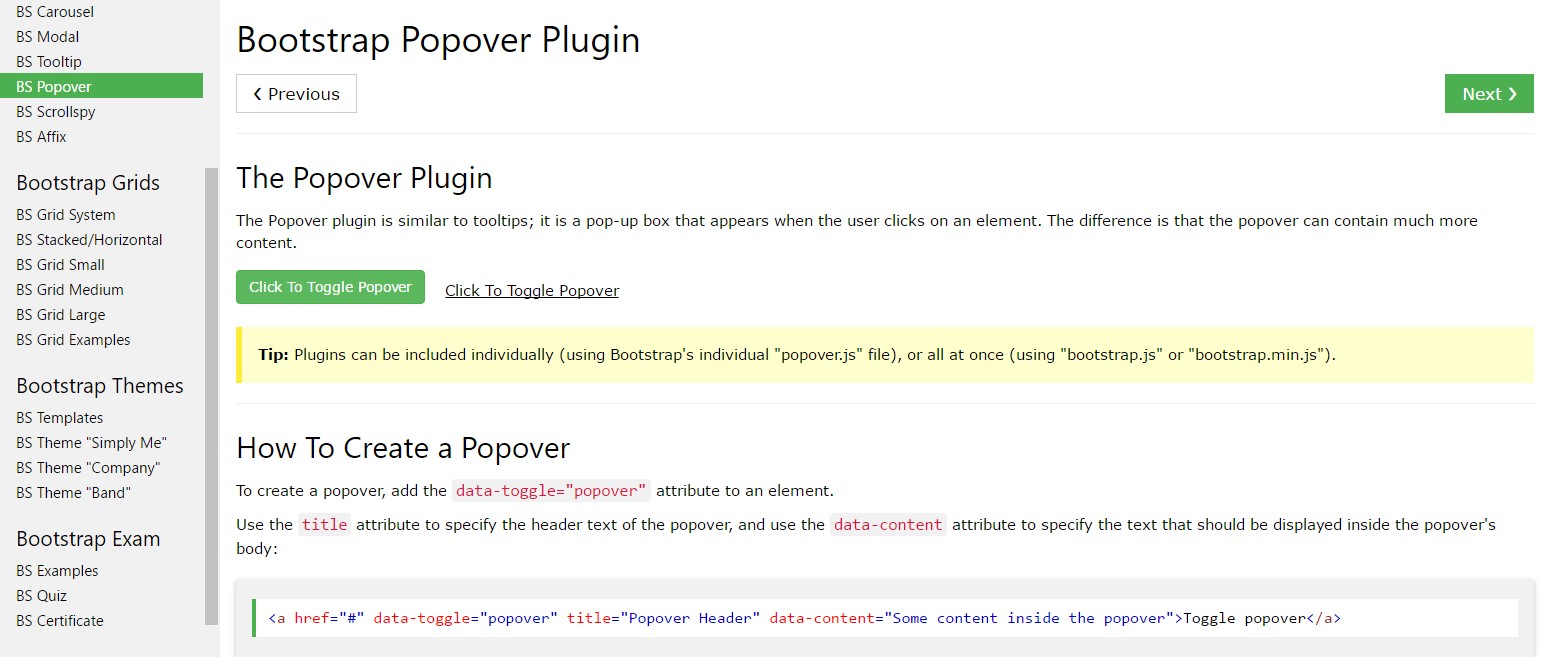
Bootstrap Popover question
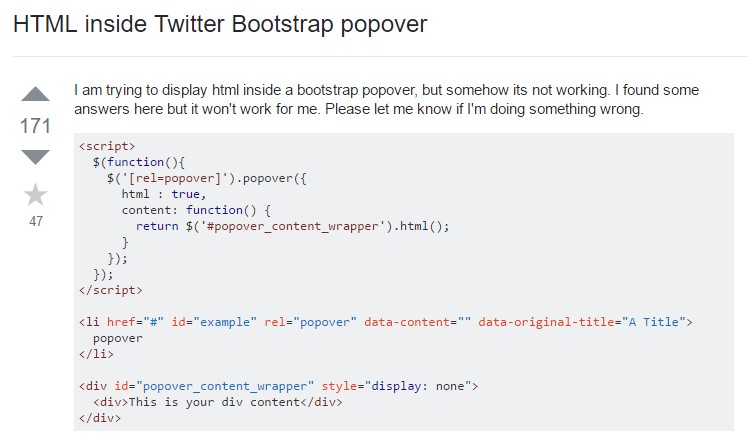
$().popover(options)
Initializes popovers for the component variety.
.popover('show')
Reveals an element's popover. Come back to the user before the popover has certainly been shown (i.e. before the shown.bs.popover event occurs). This is regarded as a "manual" triggering of the popover. Popovers whose both title and content are zero-length are never featured.
$('#element').popover('show').popover('hide')
Disguises an element's popover. Returns to the caller right before the popover has in fact been covered (i.e. prior to the hidden.bs.popover activity happens). This is considered a "manual" triggering of the popover.
$('#element').popover('hide').popover('toggle')
Activate an element's popover. Returns to the caller just before the popover has actually been demonstrated or taken cover (i.e. just before the shown.bs.popover or hidden.bs.popover activity takes place). This is looked at a "manual" triggering of the popover.
$('#element').popover('toggle').popover('dispose')
Disguise and destroys an element's popover. Popovers that put to use delegation (which are generated using the selector option) can not actually be individually gotten rid of on descendant trigger features.
$('#element').popover('dispose')Events

$('#myPopover').on('hidden.bs.popover', function ()
// do something…
)Take a look at a few video clip tutorials regarding Bootstrap popovers
Related topics:
Bootstrap popovers official documentation

Bootstrap popovers short training

Bootstrap Popover question
